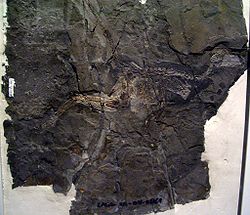Theropod
Theropods ('beast foot') are a group of bipedal saurischian dinosaurs.
| Theropods | |
|---|---|

| |
| Mounted skeleton of Coelophysis bauri, Cleveland Museum of Natural History | |
| Scientific classification | |
| Kingdom: | Animalia |
| Phylum: | Chordata |
| Clade: | Saurischia |
| Clade: | Theropoda Marsh, 1881 |
| Subgroups[1] | |
Although they were primarily carnivorous, a number of theropod groups evolved herbivory, omnivory and insectivory.[2]
Today, they are represented by 10,000 living species of birds, which evolved in the Upper Jurassic from small feathered coelurosaurian theropods.
Among the features linking theropods to birds are bipedalism, the three-toed foot, a furcula (wishbone), air-filled bones, feathers and brooding of the eggs.
Early theropods
Theropods first appear in the earliest part of the Upper Triassic about 230 million years ago. They were the sole large terrestrial carnivores from the Lower Jurassic until the close of the Cretaceous, about 66 million years ago.
Some of the earliest and most primitive of the theropod dinosaurs were:
- Eodromaeus
- coelophysids, a family including Coelophysis
Theropod Media
In the modern fauna, theropods are represented by over 11,000 species of birds, which are a group of maniraptoran theropods within the clade Avialae.
Specimen of the troodontid Jinfengopteryx elegans, with seeds preserved in the stomach region
Size comparison of selected giant theropod dinosaurs – the longest (left) is Spinosaurus aegyptiacus, shortest (right) is Carcharodontosaurus saharicus.
An adult male bee hummingbird, the smallest known theropod and the smallest living dinosaur
An ostrich walking on a road in Etosha National Park, Namibia
Mummified enantiornithean wing (of an unknown genus) from Cenomanian amber from Myanmar
Diagram of Deinonychus (left) and Archaeopteryx (right) forelimbs illustrating wing-like posture
Possible early forms Herrerasaurus (large) and Eoraptor (small)
Othniel Charles Marsh, who coined the name Theropoda. Photo c. 1870
Related pages
References
- ↑ Holtz, Thomas R., Jr. (2012). Dinosaurs: The Most Complete, Up-to-Date Encyclopedia for Dinosaur Lovers of All Ages, Winter 2011 Appendix.
- ↑ Zanno L.E; Gillette D.D; Albright L.B. and Titus A.L. 2009. A new North American therizinosaurid and the role of herbivory in 'predatory' dinosaur evolution. Proceedings of the Royal Society B, Published online before print July 15, 2009, doi: 10.1098/rspb.2009.1029.







